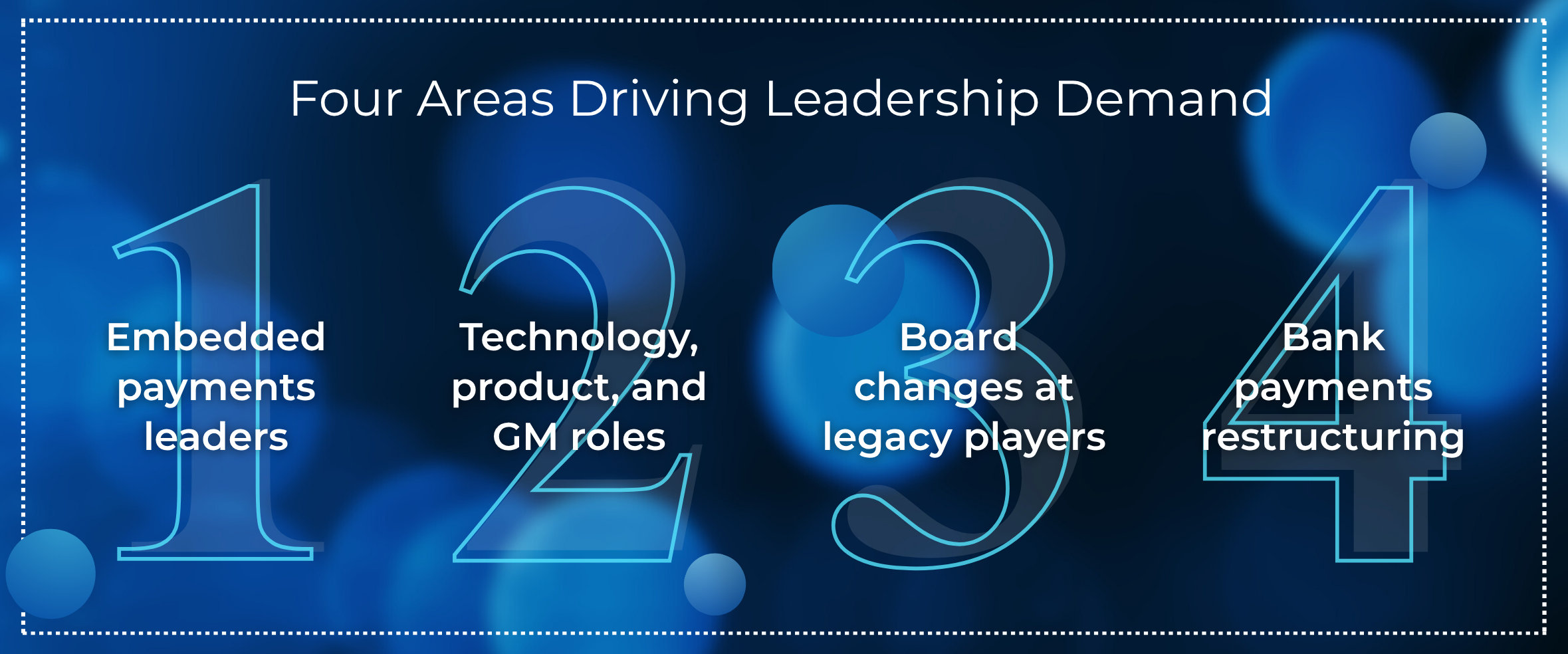The most significant leadership roles in financial services and fintech today are emerging at the dynamic intersections of private equity, technological disruption, and cross-domain expertise. The defining characteristic of the 2025 executive talent market is convergence. The lines between finance and technology have blurred permanently, creating a new landscape where leadership demands fluency across multiple disciplines.
In this report, executive search experts at True’s CEO, Board and Financial Services Practices analyze the key sectors where this transformation is most acute, and provide a data-driven roadmap for companies seeking to build the teams that will define the future of the industry.

High Demand from the Software Sector
The most consistent executive hiring activity is concentrated in software companies selling into the financial services industry. PE and VC firms are driving this calculated strategy by continuing to invest aggressively in solutions for critical pain points across the front, middle, and back offices of financial institutions.
This is a direct result of high SaaS market multiples, strategic carve-outs of non-core technology assets from larger fintech and financial services companies, and platform recapitalizations designed to fuel the next stage of growth.
This has been the most active market from a hiring perspective, with significant activity across all functions in several key categories:
- Capital markets software: Leaders who can manage complex product suites, with GTM experience in SaaS and services selling into trading, asset management, and wealth management clients.
- Core banking software: The shift from legacy systems to cloud-native, SaaS platforms demands GMs and engineering leaders with deep cloud expertise, as well as domain experience selling into credit unions and community banks.
- Governance, risk, and compliance: Need for fintech and SaaS experts with deep experience in payments, fraud, and risk management.
- Insurance software: Similar to other sectors, domain and B2B selling continues to be the most attractive talent here.
- Wealth management software: Market consolidation and M&A has been driving demand for various roles in this sector.
- Fund administration: Need for operations and technology leaders who can manage the transition to real-time, transparent data portals for LPs and GPs.
Talent for Recalibrated Payments
The payments sector, an incredibly active category for the last decade, has entered a new phase. Market consolidation and the scale advantages now held by established, tech-forward platforms have driven a slowdown in hiring for standalone payment companies.
However, executive hiring remains highly active in four specific areas as larger players continue to upgrade talent in aggressive growth mode:
Embedded payments leaders: An incredibly active role, vertical software companies are seeking leaders to build and manage embedded payments functions.
Board changes at legacy players: Legacy payment companies are undergoing changes at the board level, creating new opportunities for directors.
Technology, product, and GM roles: Mid-market (PE-backed) and large, established payment organizations continue to hire for technology, product, and general management roles.
Bank payments restructuring: Banks are fundamentally reworking their payments organizations to incorporate the introduction of stablecoins, creating a need for new leadership.

How Lending and Insurance Are Redefining Core Talent
Lending is in the midst of a cyclical pivot from a defensive to an offensive posture, while insurance is undergoing a more fundamental convergence of talent pools.
Lending’s Pivot from Defense to Offense
The lending market’s talent needs have shifted dramatically in response to macroeconomic conditions. The Federal Reserve’s rapid rate hikes in mid-2022 created a spike in demand for senior executives with expertise in credit risk, underwriting, and portfolio management. Finance and capital markets leaders who could restructure and turn around these businesses to restore profitability were also in high demand.
As of 2024-2025, with interest rates stabilized and credit performance normalized, the market has pivoted to growth and commercial go-to-market (GTM) hiring.
Insurance’s Structural Talent Blending
The insurance industry is being reshaped by two powerful forces: M&A and digitization. The consolidation among aggregators, MGAs, and PE-backed roll-ups is driving intense demand for CFOs, corporate development leaders, and post-merger integration specialists.
A structural blending of talent pools is also underway. Carriers and brokers, needing to modernize, are seeking leaders with strong digital skills, while insurtechs are now aggressively hiring executives with deep expertise from traditional insurance backgrounds.

The PE-Driven Consolidation Wave in Wealth Management
Consolidation, private equity investment, and the need to modernize advisor productivity is fueling significant change in wealth management. PE has moved from the sidelines to become a prime driver in the RIA world, with PE-backed consolidators now accounting for more than half of all RIA acquisitions.
This consolidation wave is creating urgent demand for executive roles, as RIAs and independent firms consistently point to leadership and specialized roles as their biggest gaps. Key hiring needs include Heads of Advisors, Chief Growth Officers, and Heads of Organic Growth.
Some key trends:
- As firms prioritize organic growth, they seek CROs, Heads of Growth, and advisor enablement leaders to build partnerships with banks and track KPIs for AUM growth and retention.
- Firms need marketing and client experience leaders focused on segmentation (targeting UHNW and next-gen clients) and building acquisition playbooks.
- As firms deal with increasingly complex tech stacks, they demand vendor management and integration talent on the operations and tech side.
- Digital, data, and AI acumen are becoming non-negotiable requirements, with firms embedding AI and machine learning into advisor workflows.
Crypto’s Demand for Cross-Over Leadership
As the crypto industry matures, fintech, broader tech, and crypto are merging from both a talent and company strategy perspective. This evolution has created a key theme: the need for “cross-over talent”. These are executives with mixed backgrounds across technology, traditional finance, fintech, and crypto.
This demand is concentrated in several hiring hotspots:
- Exchanges and brokerages
Exploring new product areas like prediction markets and hiring consumer, exchange, fintech and crypto entrepreneurs. - Blockchain-as-a-Service (BaaS)
These firms are hiring traditional financial services talent, putting an emphasis on deep domain expertise. - Stablecoin companies
Aggressively hiring payment, fintech, and cross-over talent.
- International expansion
Foreign-based companies are hiring senior US leadership across the C-level, General Managers, and Product/GTM roles. - Protocols
Aggressively hiring cross-over talent who can bridge the gap with traditional enterprises to focus on real-world use cases.
The ultimate expression of this convergence is the rise of the Digital Asset Treasury (DAT) business. These entities are evolving from small teams into fully-fledged operations of 10-15+ full-time employees. Leading a DAT requires a highly specialized combination of skills, creating urgent demand for CEOs and other senior leaders.
The ideal candidate must possess:

- Public company operating experience because DATs are public companies
- Deep capital markets experience with a background in raising capital
- Buy-side/sell-side experience from an asset manager, actively managed fund, or hedge fund
- M&A/corporate development experience
- Private equity and/or banking background
- Authentic crypto passion and advocating for a specific ecosystem to win the trust of both crypto-native communities and traditional investors

Looking Ahead: The Redefinition of Executive Readiness
The influence of private equity is professionalizing entire sectors, the demand for talent has shifted from siloed expertise to blended, cross-domain capabilities, and fluency in data and AI has become a baseline requirement for leadership.
Today’s most effective executives are strategists who can operate across several domains. They understand how to leverage technology to create scalable operating models, how to navigate the complex demands of PE ownership, and how to attract and lead multi-disciplinary teams.
The most valuable leader in 2025 and beyond will be fluent in the languages of capital markets, scalable technology, and decentralized ecosystems. Their unique value will be the ability to translate strategy across these domains and build the teams that can execute within this new, converged reality. This is the new benchmark for executive readiness.
WRITTEN BY

Jon Pomeranz
Managing Director, Head of the CEO, Board, and FinTech & Financial Services Practices
For media inquiries, contact Jillian Ruggieri


